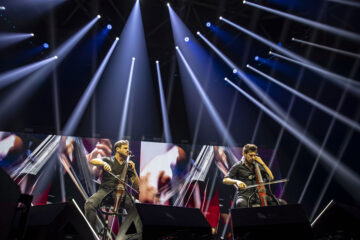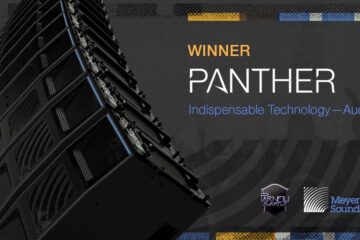ST Engineering Antycip Delivers ONERA’s State-of-the-art New Flight Simulator
The French aerospace lab’s new flight simulator brings together the latest technologies including 3D capabilities, separate and dynamic POV for pilot and co-pilot, and head and hand tracking.


 ONERA provided the cockpit and the PC Suite, though ST Engineering Antycip suggested the right computer specs for the job. The content, which also comes from ONERA, is fed via display port (two PCs per projector) and viewed using VR Vantage.
“There were also some very specific constraints about the surroundings,” said Blancheri. “There are military jets that regularly fly above and there is a quarry nearby with regular explosions, so it was important to make sure everything was properly rigged and that there was an auto-calibration or scalable display that could be called up at the touch of a button.
“We selected ST Engineering Antycip because their technical offer met all of our requirements within the budget we had set. We are fully satisfied with the work done by ST Engineering Antycip, and the result exceeded our expectations. ONERA’s new SCHEMAX simulator now has a professional projection system allowing us to put the pilot and co-pilot in an immersive and realistic visual environment,” said Gregory Bonin, research engineer at ONERA, in charge of the programme.
ST Engineering Antycip’s France and Spain director, Johan Besnainou, concluded: “The SCHEMAX simulator built for ONERA was one with so many functionalities, and it was yet another successful strategic project for us. We hope that the SCHEMAX project will be a long-term one to allow us to continue our great working relationship with ONERA and pledge our ongoing support.”
Photos courtesy of ONERA
Since 1996, ST Engineering Antycip (formerly Antycip Simulation) has supported customers across the globe, in defence, academia, commerce and industry, to become better at what they do. As an expert provider of simulation, analysis, modelling, display and virtual reality solutions, ST Engineering Antycip combines its in-house technical expertise with an unrivalled range of products from software and hardware providers. ST Engineering Antycip is a subsidiary of ST Engineering. For more information, visit https://steantycip.com.
ONERA is the French national laboratory for aeronautics and space R&T, staffed by 2000 people. Under the supervision of the French Ministry of Armed Forces, ONERA has an annual budget of 234 million euros, of which more than half comes from commercial contracts. As the French expert in aerospace technologies, ONERA prepares tomorrow’s defenses, meets the aerospace challenges of the future, and contributes to the competitiveness of the European aerospace industry. ONERA masters all the disciplines and technologies in its aerospace fields. All major civil and military aerospace programs in France and Europe contain „DNA“ from ONERA: Ariane, Airbus, Falcon, Rafale, missiles, helicopters, engines, radars, etc.
ONERA provided the cockpit and the PC Suite, though ST Engineering Antycip suggested the right computer specs for the job. The content, which also comes from ONERA, is fed via display port (two PCs per projector) and viewed using VR Vantage.
“There were also some very specific constraints about the surroundings,” said Blancheri. “There are military jets that regularly fly above and there is a quarry nearby with regular explosions, so it was important to make sure everything was properly rigged and that there was an auto-calibration or scalable display that could be called up at the touch of a button.
“We selected ST Engineering Antycip because their technical offer met all of our requirements within the budget we had set. We are fully satisfied with the work done by ST Engineering Antycip, and the result exceeded our expectations. ONERA’s new SCHEMAX simulator now has a professional projection system allowing us to put the pilot and co-pilot in an immersive and realistic visual environment,” said Gregory Bonin, research engineer at ONERA, in charge of the programme.
ST Engineering Antycip’s France and Spain director, Johan Besnainou, concluded: “The SCHEMAX simulator built for ONERA was one with so many functionalities, and it was yet another successful strategic project for us. We hope that the SCHEMAX project will be a long-term one to allow us to continue our great working relationship with ONERA and pledge our ongoing support.”
Photos courtesy of ONERA
Since 1996, ST Engineering Antycip (formerly Antycip Simulation) has supported customers across the globe, in defence, academia, commerce and industry, to become better at what they do. As an expert provider of simulation, analysis, modelling, display and virtual reality solutions, ST Engineering Antycip combines its in-house technical expertise with an unrivalled range of products from software and hardware providers. ST Engineering Antycip is a subsidiary of ST Engineering. For more information, visit https://steantycip.com.
ONERA is the French national laboratory for aeronautics and space R&T, staffed by 2000 people. Under the supervision of the French Ministry of Armed Forces, ONERA has an annual budget of 234 million euros, of which more than half comes from commercial contracts. As the French expert in aerospace technologies, ONERA prepares tomorrow’s defenses, meets the aerospace challenges of the future, and contributes to the competitiveness of the European aerospace industry. ONERA masters all the disciplines and technologies in its aerospace fields. All major civil and military aerospace programs in France and Europe contain „DNA“ from ONERA: Ariane, Airbus, Falcon, Rafale, missiles, helicopters, engines, radars, etc.


